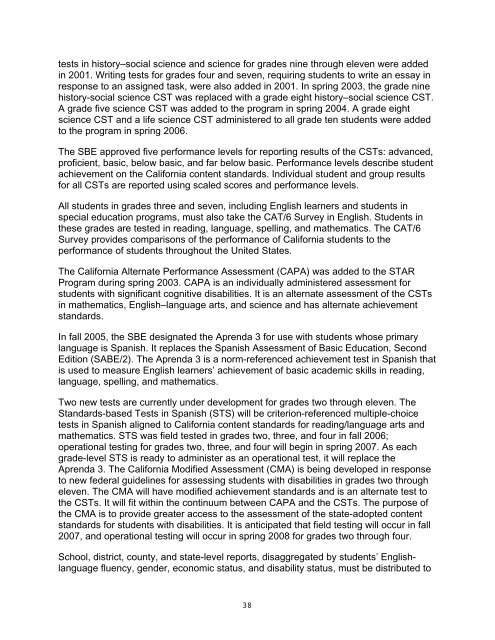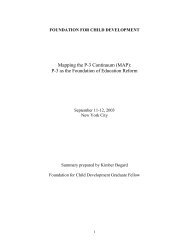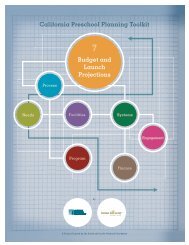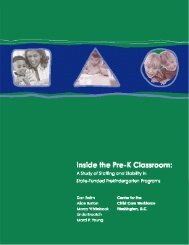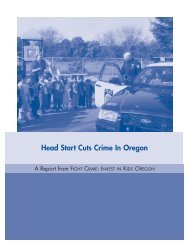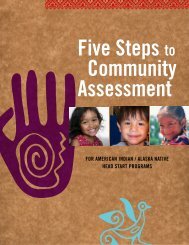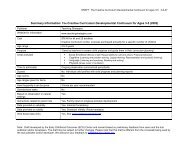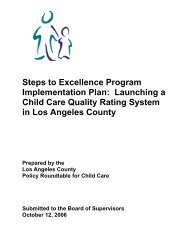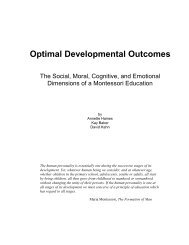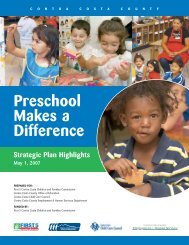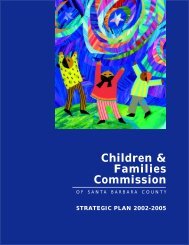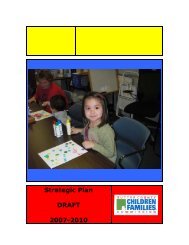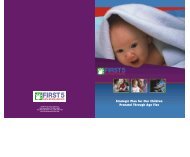Download this file - Plan4Preschool
Download this file - Plan4Preschool
Download this file - Plan4Preschool
Create successful ePaper yourself
Turn your PDF publications into a flip-book with our unique Google optimized e-Paper software.
tests in history–social science and science for grades nine through eleven were added<br />
in 2001. Writing tests for grades four and seven, requiring students to write an essay in<br />
response to an assigned task, were also added in 2001. In spring 2003, the grade nine<br />
history-social science CST was replaced with a grade eight history–social science CST.<br />
A grade five science CST was added to the program in spring 2004. A grade eight<br />
science CST and a life science CST administered to all grade ten students were added<br />
to the program in spring 2006.<br />
The SBE approved five performance levels for reporting results of the CSTs: advanced,<br />
proficient, basic, below basic, and far below basic. Performance levels describe student<br />
achievement on the California content standards. Individual student and group results<br />
for all CSTs are reported using scaled scores and performance levels.<br />
All students in grades three and seven, including English learners and students in<br />
special education programs, must also take the CAT/6 Survey in English. Students in<br />
these grades are tested in reading, language, spelling, and mathematics. The CAT/6<br />
Survey provides comparisons of the performance of California students to the<br />
performance of students throughout the United States.<br />
The California Alternate Performance Assessment (CAPA) was added to the STAR<br />
Program during spring 2003. CAPA is an individually administered assessment for<br />
students with significant cognitive disabilities. It is an alternate assessment of the CSTs<br />
in mathematics, English–language arts, and science and has alternate achievement<br />
standards.<br />
In fall 2005, the SBE designated the Aprenda 3 for use with students whose primary<br />
language is Spanish. It replaces the Spanish Assessment of Basic Education, Second<br />
Edition (SABE/2). The Aprenda 3 is a norm-referenced achievement test in Spanish that<br />
is used to measure English learners’ achievement of basic academic skills in reading,<br />
language, spelling, and mathematics.<br />
Two new tests are currently under development for grades two through eleven. The<br />
Standards-based Tests in Spanish (STS) will be criterion-referenced multiple-choice<br />
tests in Spanish aligned to California content standards for reading/language arts and<br />
mathematics. STS was field tested in grades two, three, and four in fall 2006;<br />
operational testing for grades two, three, and four will begin in spring 2007. As each<br />
grade-level STS is ready to administer as an operational test, it will replace the<br />
Aprenda 3. The California Modified Assessment (CMA) is being developed in response<br />
to new federal guidelines for assessing students with disabilities in grades two through<br />
eleven. The CMA will have modified achievement standards and is an alternate test to<br />
the CSTs. It will fit within the continuum between CAPA and the CSTs. The purpose of<br />
the CMA is to provide greater access to the assessment of the state-adopted content<br />
standards for students with disabilities. It is anticipated that field testing will occur in fall<br />
2007, and operational testing will occur in spring 2008 for grades two through four.<br />
School, district, county, and state-level reports, disaggregated by students’ Englishlanguage<br />
fluency, gender, economic status, and disability status, must be distributed to<br />
38


